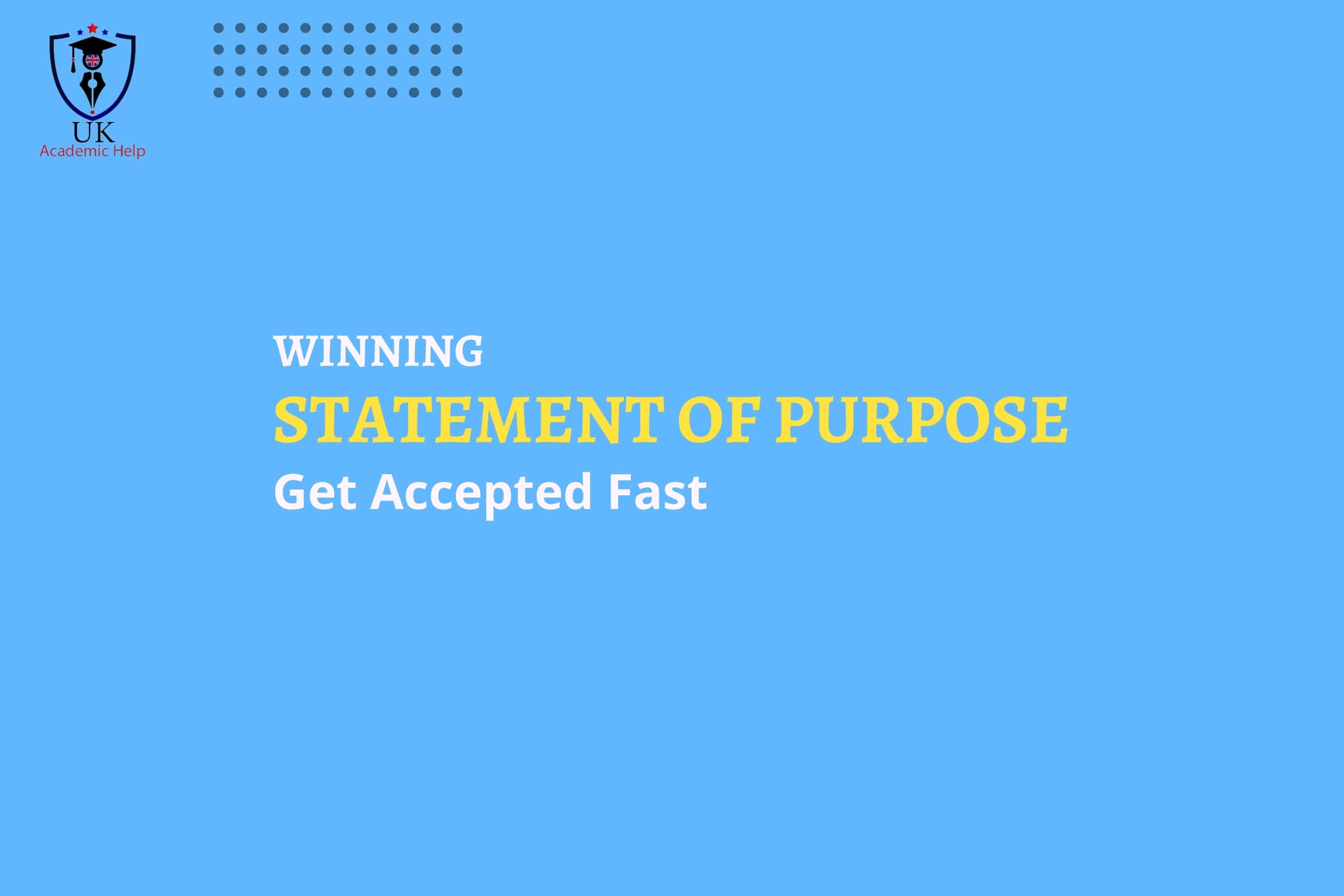Table of Contents
- 1 What Is a Statement of Purpose (SOP)?
- 2 Why a Strong SOP Can Make or Break Your Application
- 3 Statement of Purpose Structure and Format
- 4 How to Write a Statement of Purpose
- 5 What to Include in Your Statement of Purpose
- 6 Winning Statement of Purpose Examples
- 7 Expert SOP Writing Tips from Admission Consultants
- 8 Need Help? Get a Custom SOP from Experts
- 9 Frequently Asked Questions
What Is a Statement of Purpose (SOP)?
A Statement of Purpose, often shortened to SOP, is a written document that outlines your academic background, interests, motivations, and future goals. It’s typically required as part of your application to postgraduate or graduate admission programs, particularly in the UK, US, and other competitive education systems.
An SOP gives you the chance to introduce yourself beyond test scores and transcripts. It tells the admission committee what drives you, what your academic goals are, and why you’re applying to a specific course or university. It’s your opportunity to make a strong impression through your words and demonstrate your readiness and fit for the program.
Purpose of SOP in Graduate Admissions
The SOP plays a vital role in helping universities assess applicants beyond raw academic data. It’s not just a formality—it provides insights into your research interests, career objectives, and intrinsic motivation.
Universities receive thousands of applications, and your SOP serves as a filter. It helps admission teams understand:
- What your goals are
- Whether your ambitions align with the program’s offerings
- How your past experience supports your future plans
In short, it’s a bridge between who you are and what you want to achieve academically and professionally.
Statement of Purpose vs. Personal Statement
While often used interchangeably, there’s a difference between a statement of purpose and a personal statement.
- An SOP is academic and future-focused. It discusses your academic background, achievements, research goals, and career objectives.
- A personal statement, however, focuses more on your personal narrative, life experiences, and how those experiences shaped your decision to pursue a specific path.
In the UK, some universities may accept either, depending on the course. However, for postgraduate and research-based programs, an SOP is usually required.
Who Reads Your SOP?
Your SOP is typically reviewed by the admission committee—a group of faculty members or admissions officers responsible for selecting applicants for the program.
They evaluate it to determine:
- Whether you’re academically prepared for the course
- If your research interests align with the department’s strengths
- How your motivation and goals match the ethos of the institution
They’re not just looking at grammar—they’re assessing whether your profile fits into their academic community and if you have the potential to succeed.
Why a Strong SOP Can Make or Break Your Application
A well-written SOP can be the deciding factor when you’re up against applicants with similar qualifications.
It can:
- Offset slightly lower grades or test scores
- Highlight unique aspects of your background or experience
- Show clarity in your academic goals and long-term vision
When admissions are competitive, an average SOP won’t do. A strong one positions you as a serious and prepared candidate.
Role in Admission Decisions
Your SOP holds significant weight in the graduate admission process. Many institutions use it as a tool to:
- Differentiate between applicants with similar academic records
- Understand how you will contribute to the academic community
- Identify students whose goals and motivations align with the program’s mission
In essence, it can either elevate your application—or drag it down if done poorly.
Importance of Storytelling and Clarity
Your SOP isn’t just a list of facts—it should be a clear, structured account of your journey. Admissions officers value a natural, human tone that explains:
- What led you to this field
- Why you’re choosing this course
- How your achievements and experiences support your goals
A strong narrative arc keeps readers engaged. But clarity is just as important—avoid vague language and stay focused on relevant details.
Common Mistakes Students Make
Many students lose their edge by making these mistakes:
- Using generic templates without customisation
- Writing without a clear structure
- Including unrelated personal stories
- Overusing complex or overly academic language
- Repeating information already covered in the application
Other common errors include neglecting to proofread, ignoring the program’s focus, or writing without showing a clear sense of direction or motivation.
How to Order Your Custom SOP
Getting started is simple:
- Visit our Contact Page
- Send us your details and university requirements
- A writer will connect with you directly to begin the process
- You’ll receive your completed SOP within the deadline
Need help urgently? Message us on WhatsApp: +44 744 191 5956
Statement of Purpose Structure and Format
A well-structured SOP follows a logical flow that keeps readers engaged and makes your intent easy to understand. This helps both admission committees and search engines understand the context and value of your content.
Let’s explore the ideal format, layout, and a simple template to follow.
Ideal SOP Structure (Introduction, Body, Conclusion)
Here’s the standard structure that most successful SOPs follow:
Introduction:
Briefly state your purpose for applying. Share what interests you in the field and what your current goal is.
Body Paragraphs:
Cover the following in a natural progression:
- Your academic background and key achievements
- Any research or work experience related to the field
- Academic goals and how they relate to the course
- Career objectives and what you hope to do post-graduation
Conclusion
Reinforce your motivation, clarify your fit, and express enthusiasm for the opportunity.
Formatting Tips (Word Count, Layout, Flow)
- Word count: Most universities suggest 500–1,000 words
- Font: Use a clean font like Arial or Times New Roman, size 11 or 12
- Spacing: Use 1.0 or 1.15 spacing for readability
- Flow: Each section should lead naturally to the next—no abrupt jumps
- Consistency: Keep tone and tense consistent throughout
Good structure flow and formatting show attention to detail—something every admission committee values.
SOP Template You Can Follow
Here’s a simple, clean SOP template to help guide your writing:
- Paragraph 1: Brief introduction to your interest in the field
- Paragraph 2: Summary of your academic background
- Paragraph 3: Work/research experience and any projects
- Paragraph 4: Your research interests and future goals
- Paragraph 5: Why this university/program is the right fit
- Paragraph 6: Strong closing that reflects enthusiasm and confidence
Use this as a base and adjust according to your story, motivation, and the specific university’s expectations.
How to Write a Statement of Purpose
Writing a Statement of Purpose may feel like a big task, but breaking it down into steps makes it manageable. It’s about explaining who you are, what you’ve done, and where you’re headed, all in a clear, organised way.
Step-by-Step Writing Process
Start by understanding the goal of your SOP. You’re showing the admission committee why you’re a good choice for the program. Keep your tone confident and your sentences straightforward.
Here’s a practical sequence:
- Begin with a brief introduction about your interest in the field.
- Discuss your academic background, focusing on relevant achievements.
- Explain any practical or research experience you’ve had.
- Share your academic goals and long-term career objectives.
- Mention what draws you to the specific program or university.
- End with a clear conclusion that ties everything together.
Each part should build on the last, keeping a steady structure flow from start to finish.
Planning and Outlining Your SOP
Before you start writing, spend time planning. Jot down what you want to include—this keeps your SOP focused and relevant. Outline your points so you don’t end up repeating yourself or missing anything important.
During this phase, think about:
- Your intrinsic motivation: Why are you pursuing this subject?
- Your strengths: What do you bring to the table?
- Your goals: Where do you see this degree taking you?
An outline doesn’t just help you stay on track—it makes your SOP easier to write and better to read.
Drafting, Editing, and Proofreading Tips
Once your outline is set, write the first draft freely. Don’t worry too much about perfection here—just get your thoughts out. Then move to revision mode.
When editing:
- Look for clarity and consistency.
- Trim any extra words or repeated ideas.
- Check the word count limits set by the university.
- Make sure each paragraph flows naturally into the next.
Don’t skip proofreading. Spelling or grammar errors can hurt your impression, no matter how strong your message is. If possible, ask someone you trust to review it—or consider getting help from academic editors.
What to Include in Your Statement of Purpose
Admissions officers are not just looking for grades—they want to know who you are, what drives you, and how you’ll add value to their program. Your SOP should present a complete picture of your academic journey and future goals.
Academic Background and Achievements
Start by highlighting your academic path so far. Mention degrees you’ve earned, subjects you’ve studied, and key achievements that show your strengths.
Focus on areas that connect with your target program. If you’ve done any projects, papers, or coursework that directly relate to the course, mention them with a brief explanation of their impact or outcome.
Research Interests and Academic Goals
Explain what areas within your field genuinely interest you. Are there specific topics, problems, or trends you want to explore further?
This is where you align your academic goals with what the program offers. Show that you’ve looked into the university and how its resources or faculty support your direction. Keep the tone honest and future-focused.
Career Objectives and Future Plans
Admissions committees want to know you have a clear sense of purpose. After completing your course, what do you hope to do next?
Whether you’re aiming for further study, academic research, or a role in a specific industry, this section helps prove your seriousness. Keep it realistic and make sure it ties back to your academic background.
Unique Strengths and Motivation
Think about what sets you apart from other applicants. It might be your mindset, your commitment, a challenge you’ve overcome, or a unique combination of experiences.
Also reflect on your motivation—what’s the personal reason you chose this field? Don’t overthink it. The goal is to show sincerity and a genuine interest in what you’re applying for.
Why You’re a Perfect Fit for the Program
Here’s where you make the connection between you and the university. Talk about what you admire about the program, the faculty, the structure, or the values of the school.
Show that you understand what the program is about and why it matches your needs and direction. The better this connection is made, the more confident the admission committee will feel about your application.
Winning Statement of Purpose Examples
Examples give clarity. They help you understand what a good SOP looks like, and how ideas are structured in real writing. Below are examples specifically relevant for postgraduate students.
Statement of Purpose Example for Master’s
Introduction:
I developed a deep interest in environmental science during my undergraduate studies, especially after completing a research project on water pollution.
Academic Background:
I earned my bachelor’s degree in Environmental Science from the University of Birmingham, where I studied modules in ecology, environmental chemistry, and sustainable development.
Research Interests:
My current interest lies in climate risk assessment and mitigation. I aim to study how data-driven approaches can improve disaster preparedness strategies.
Career Goals:
After completing this Master’s program, I hope to work in environmental policy consulting in the UK or Europe.
Program Fit:
The MSc in Environmental Change and Management at your university aligns with my academic interests and offers access to leading researchers in climate analytics.
Conclusion:
I am confident that this program will help me deepen my knowledge and contribute to the field of climate action.
Real Sample with Breakdown (Annotated)
Here’s a simplified breakdown of what the above SOP did well:
- Clear introduction that states interest
- Connects background with research and career goals
- Strong reasoning for university selection
- Flows naturally with a beginning, middle, and end
- Professional tone with personal touches
This kind of narrative arc helps the SOP read like a story, while staying relevant and informative.
Personal Statement Example for Comparison
While the above was an SOP, here’s how a personal statement might begin differently:
From a young age, I’ve been drawn to nature and its processes. Growing up near the coast, I often observed the changing tides and weather patterns. This fascination turned into academic curiosity, leading me to pursue Environmental Science…
Unlike the SOP, this starts with a personal memory and emotion, setting the tone for a story-led account. Both are valid forms of expression—but remember: for postgraduate admissions, the SOP carries more academic weight.
Expert SOP Writing Tips from Admission Consultants
Having worked with students across a range of postgraduate programs, expert consultants know what makes an SOP work. These tips are based on real feedback from admission committees, common patterns in successful SOPs, and the mistakes that usually hold applicants back.
How to Stand Out to the Admission Committee
If you want your SOP to stand out, don’t just write what you’ve done—explain why it matters. Highlight your motivation, your fit with the program, and your goals clearly.
Mention specific aspects of the course or university that you’ve researched. This shows genuine interest and effort, which the admission team values.
Focus on your unique selling point—what makes your academic journey and future direction worth considering over others with similar grades.
Addressing Weaknesses Positively
If there’s a gap in your academics or a semester that didn’t go as planned, address it without overexplaining. Be honest but focused.
Briefly mention the issue, then shift attention to what you learned or how you improved. For example, if your grades dipped during a term, link it to how you bounced back with stronger performance in final-year coursework or research.
This shows maturity and awareness—qualities that often matter as much as grades.
Tone, Voice, and Storytelling Balance
Write as if you’re speaking directly to someone on the admission committee. Avoid being too casual, but keep your tone friendly and direct.
Use your personal narrative wisely—share moments that shaped your academic direction, but keep the spotlight on what you’ve learned, what motivates you, and what you plan to do.
Avoid sounding overly formal or robotic. A natural tone paired with clarity and structure will keep the reader engaged.
Proofreading and Polishing Like a Pro
The final step is where good SOPs become great. Always revise your draft multiple times.
Check for grammar, spelling, structure flow, and word limits. Make sure your tone is consistent and each paragraph serves a purpose.
Reading aloud helps catch awkward phrasing or unnecessary repetition. If possible, ask someone else to review it—or get support from academic editors for a second opinion.
Need Help? Get a Custom SOP from Experts
Writing an SOP that gets noticed takes more than filling in a template. If you’re short on time or unsure where to begin, getting expert help can make the process less stressful and more effective.
Why Choose Professional SOP Writing Help
When you work with experienced academic writers, you get focused support that aligns with university requirements and program expectations.
At UK Academic Help, we’ve supported thousands of students applying to universities across the UK and beyond. Our approach is built on clarity, structure, and making your SOP truly reflect your goals.
What Our Service Offers (Template, Revision, Consultation)
Here’s what we provide as part of our SOP writing and editing service:
- A well-organised SOP written specifically for your degree and field
- A polished structure using proven templates and formatting best practices
- Multiple rounds of revision and proofreading to meet application guidelines
- Optional consultation to discuss your academic path and future plans
We focus on clear writing that connects with the reader, highlights your academic strengths, and reflects your direction.
How to Order Your Custom SOP
Getting started is simple:
- Visit our Contact Page
- Send us your details and university requirements
- A writer will connect with you directly to begin the process
- You’ll receive your completed SOP within the deadline
Need help urgently? Message us on WhatsApp: +44 744 191 5956
Frequently Asked Questions
What’s the Ideal Word Count for an SOP?
Most universities expect SOPs to be between 500 to 1,000 words. Always check the official guidelines, but staying in this range keeps your writing focused and easier to review.
Can I Reuse My SOP for Multiple Universities?
You can reuse the base, but each SOP should be customised to match the university’s specific focus and expectations. Mentioning the wrong school name or missing unique program features can hurt your chances.
How Personal Should a Personal Statement Be?
A personal statement should reflect your values, motivations, and what led you to your academic goals. Keep it relevant—this isn’t a life story, but a short account of how your past connects to your future plans.








Leave A Comment